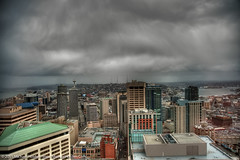
Roswell in 2009 at “age 91”
Of all the places I’ve lived–and that’s a bunch–it’s hard to top Seattle when it comes to a local love for dogs. With so many residents having two or three, I frequently observe more canines walking along sidewalks than humans. Since I became New To Seattle this summer, the number of dogs I see on a daily basis beats anything I witnessed when I lived years ago in New York City. And that’s a place so dog-driven it forced enactment of one of the nation’s first pick-up-after-your-pooch laws. To me, man’s best friend in Seattle seems more popular than even iPhones.
I, too, was a Seattle dog owner–for all of 10 days. That’s when we made the very difficult decision to put down Roswell, our basset hound so friendly she actually purred like a cat every time someone rubbed her stomach or pet her head.
Reference works say 50% of bassets die from bloat, cancer or heart problems.
Rozzie had all three, and then some, including, as it turned out, insurmountable stomach issues. They left her in a coma before we authorized a shot of pentobarbital, which humanely stopped her breathing in less than 10 seconds.
It fell to me to be the family witness to her passing.
Roswell (named after the town in her native New Mexico infamous for a bogus alien spaceship crash) died six weeks short of her 15th birthday. That’s more than three years longer than the lifespan of the average basset, and 104 in dog years. So she had a pretty good ride. That’s especially true if you don’t count the day a decade ago when a boxer bolted out of a house along the Albuquerque street named for Nobel Peace Prize winner Martin Luther King Jr. and tried to take off one of her floppy ears.
The purpose of this post is not to lament the passing of a gentle, affectionate dog or to elicit sympathy from acquaintances and total strangers in my new place of habitual abode. It’s to ponder the economics of dog ownership and the trade-offs that entails.
Why explore dogs? Well, it’s considered bad form to openly put a value on the life of a human. Of course, this is done quietly across the country all the time in wrongful-death lawsuits, government rule-making and private-sector decision-making on safety issues like whether there should be more steel in that tiny car.
Even though they become family members, dogs are a lot easier to discuss, even if just as emotionally. And the issues bear more than a passing similarity to the great national debate over health care costs and insurance (for humans) and, more broadly, the proper allocation of limited resources.
Obama and Boehner, pay attention!
Thanks to the magic of a 20-year-long Quicken file and my bean-counter personality, I know to the penny what Rozzie cost since her birth in Albuquerque on September 2, 1996. The total: $36,846.24. That included the $250.00 we paid for her on October 18, 1996, six weeks after her birth, and the expenses attendant to her final illness, about which more in a bit.
The average yearly cost was $2,456.42, or slightly more than $200.00 a month. If that seems high to you, that seems high to me, too. But it’s not just because we lived seven years in high-cost California, where some greedy veterinarians marking up the expensive drugs they sold routinely violated state law by refusing to give written prescriptions that could be shopped around for a lower price. Continue reading →
Share on Facebook

















